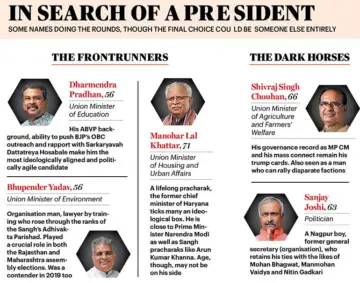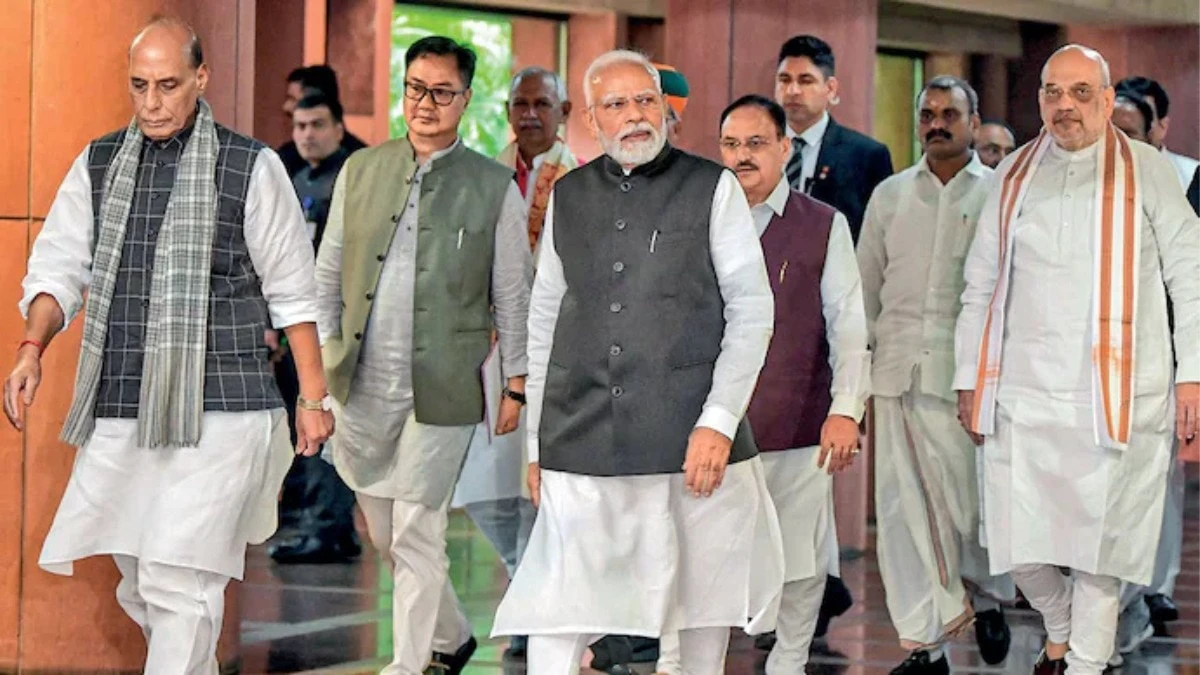(NOTE: This article was originally published in the India Today issue dated August 18, 2025)
Just when it seemed the BJP was finally getting set to elect a president, the needle moved backward again, with the imperative of finding a new vice-president for the country first.
Never mind that it has been more than a year since current president Jagat Prakash Nadda’s term came to an end-this after an extension of a year and a half from the original retirement date of January 20, 2023. The vice-presidential election is due on September 9, followed perhaps by a cabinet reshuffle and, of course, the Bihar election.
What is holding up the process? The ideological hand of the Rashtriya Swayamsevak Sangh (RSS) perhaps, which seems to have reclaimed its position behind the steering wheel after the BJP’s underwhelming 240-seat tally in the 2024 Lok Sabha election. That setback prompted the Sangh to demand a course correction. No longer content to watch from the sidelines, it has also been pressing for more say in appointments, campaign narratives and transitions at the top. So it is with the choice of president for the party.
The organisational elections that began in December 2024 were originally meant to be routine, but have now acquired a new salience. The RSS is certain that the president this time must be one of their own. Not just a charismatic campaigner, but a disciplined organiser, a Hindutva loyalist with deep roots in the Parivar ecosystem. An insider, not an import. Someone who can seamlessly lead the party into a post-Narendra Modi era. So, who fits the bill?
 THE PROBABLES
THE PROBABLES
Dharmendra Pradhan, the current Union minister of education and earlier in charge of petroleum, is one contender. His rise from the Akhil Bharatiya Vidyarthi Parishad (ABVP) stable, his ability to push the BJP’s OBC outreach without alienating the core, and his rapport with Dattatreya Hosabale, the current #2 in the RSS, make him the most ideologically aligned and politically agile candidate. He has worked closely with past party presidents: Rajnath Singh, Nitin Gadkari and Amit Shah. At 56, he offers a generational shift without provoking rebellion.
Then, there’s Bhupender Yadav, the Union environment minister and a seasoned organisation man. A lawyer by training, he rose through the ranks of the Sangh’s Adhivakta Parishad and earned his stripes as a shrewd poll manager, especially in Rajasthan and Maharashtra. In 2019, when Nadda was picked as party president, Yadav was in serious contention and was even coordinating calls to key partymen before the announcement.
Manohar Lal Khattar, former Haryana chief minister and current Union housing minister, is another possibility. A committed pracharak before entering electoral politics, Khattar ticks many ideological boxes. He enjoys proximity to Prime Minister Modi and holds favour among Sangh pracharaks like Arun Kumar. However, Khattar’s tenure as CM ended amid murmurs about his inaccessibility and a top-down style that alienated both party workers and allies. His low-key presence in the cabinet has done little to reverse that perception.
There could be dark horses too. Shivraj Singh Chouhan, former Madhya Pradesh CM and now Union agriculture minister, is one of them. Still popular within the BJP base, Shivraj has quietly built goodwill within both the cabinet and Sangh ranks. His backers include veteran pracharak Suresh Soni-who also supports Pradhan-and he is seen as a man who can rally disparate factions. His governance record and mass connect remain his trump cards. But his age could count against him: Shivraj is 66. In a party increasingly nudged toward generational change, he may be seen as a transitional figure-good for now but not in a post-Modi scenario.
Then, there is the wild card: Sanjay Joshi. A Nagpur boy, former general secretary (organisation) and an ideological purist. Joshi’s relations in Nagpur remain strong; he shares old ties with Mohan Bhagwat, Manmohan Vaidya and Nitin Gadkari. At 63, he is in the acceptable age bracket as well, but his run-ins with Modi when he was Gujarat chief minister may be a downer.
There were some rumours of a woman contender to helm the party. But no serious woman leader has emerged as a consensus candidate, and the idea may die a quiet death.
PREDICT AT YOUR PERIL
Both organisations have a history of springing surprises and, often, the more intense the speculation, the greater the likelihood that the eventual choice will be someone outside the frame. The elevation of Nitin Gadkari as party president in 2009 is a prime example. Just 52 then, Gadkari was relatively unknown outside Maharashtra, having served as state BJP president and minister in the Shiv Sena-BJP government. He had almost no experience in national politics. Yet, the Sangh-disenchanted with the infighting and stagnation of the Delhi old guard-pressed for his appointment to inject youthful energy into the party and bring ideological alignment. Gadkari’s appointment blindsided the Delhi leadership, upended power equations and marked a shift in balance in the BJP organisation.
The RSS-BJP are also not always bound by public logic or apparent credentials. They prefer consensus, not contest. And that can take weeks, even months, of deliberations and behind-the-scenes persuasion. They have also been busy, first as the party pushed their muscle for the Delhi polls, then to build the political outreach to complement Operation Sindoor and now to identify a candidate for the vice-presidential election.
As of August 2025, the party has achieved the quorum necessary to elect a new national president. According to the BJP constitution, the party must complete its internal elections in at least 50 per cent of the states and Union Territories. That threshold has been crossed, with 18-plus state units having completed the exercise, though critical states such as Uttar Pradesh, Haryana, Karnataka, Jharkhand, Gujarat and Delhi have yet to deliver. Punjab had by the first week of August named only its first six district presidents, making it last in the queue, barring strife-torn Manipur.
In UP-a state crucial for both the party as well as the Sangh’s ideological balance-four key changes are pending: a new state president, a replacement for Governor Anandiben Patel, a cabinet reshuffle and new national council nominees. The state delivered only 37 out of 80 seats in the 2024 parliamentary polls, prompting serious introspection. Chief Minister Yogi Adityanath remains popular and a key ideological figure, but the BJP’s caste arithmetic and candidate strategy need urgent recalibration ahead of the 2027 assembly election. Similar exercises are underway in Haryana, Delhi, Jharkhand, Gujarat and Karnataka.
THE POST-MODI TEST
The RSS is well aware that Narendra Modi’s mass appeal helped the Parivar reach newer demographics-urban aspirational classes, youth, women and marginalised castes. His popularity gave cover for ideological boldness and delivery on crucial agenda, be it the building of the Ram temple in Ayodhya or the abrogation of Article 370 in Jammu and Kashmir. But it also fostered top-down decision making, weakening internal debate. Now, with both Modi and RSS chief Mohan Bhagwat approaching the retirement threshold of 75, a new chapter is about to begin. No one in the BJP-Sangh expects the PM to hang up his boots anytime soon and it is agreed that he is needed to maintain their ideological and political trajectory. The next party chief will be the bridge. He will have to command the Sangh’s trust, Modi’s confidence, and the cadre’s respect. His mandate will be as much to win elections-Opposition-ruled West Bengal, Tamil Nadu and Kerala go to polls in 2026-as to restore ideological depth, forge new caste coalitions, prevent factionalism and manage transitions both within and outside Modi’s shadow.
As one party insider quipped recently: “We’re not just choosing a party president, we’re deciding who holds the map in a post-Modi landscape.” The Sangh may hold the ideological compass. But the journey ahead will depend on whom it hands that compass to.
